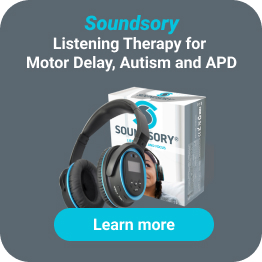Easy and Effective Gross Motor Skills Activities for Children with Autism, APD or ADHD
 Gavin Williams
Gavin Williams Physiotherapist
September 25, 2024
Gross motor skills activities are games and exercises which can help develop your growing child’s movement and coordination. They are skills which involve using the whole body. However, for some children, developing gross motor skills might take longer and require smaller milestones. For children with additional needs, patience and encouragement are key. The support of parents and caregivers alongside expert guidance can significantly accelerate progress. Helping to improve your child’s muscle strength, coordination, and ultimately, to become more independent. Developed gross motor skills not only benefit a child’s wellbeing, but also lays the foundation for developing those important fine motor skills later. This article will tell you all about what gross motor skills are and provides a free list of exercises you can do with your child anywhere. We also offer fun advice for parents and caregivers on seasonal exercises as well as aids and equipment. The Soundsory® program is a unique blend of movement, music and therapy. It perfectly compliments all the exercises you’ll discover in this free guide. Gross motor skills involve the purposeful movement of larger body parts, such as arms, legs, and trunk. They are one of the three main types of coordination alongside fine motor skills and hand-eye coordination. Improving gross motor skills helps to build confidence and paves the way for social interaction through play. It can also enable your child to move more independently and stay safe as their risk of falling or injury reduces. “Gross motor skills are so important. They lay the foundation for developing fine motor skills and better coordination as your child grows.” Colin Palmer, Pediatric Specialist Physical Therapist (UK) Physical development: Gross motor skills help children develop strong muscles and bones. Cognitive development: They contribute to spatial awareness, balance, and coordination. Social development: These skills are essential for playing with others and participating in group activities. Emotional development: Mastering gross motor skills can boost a child’s self-esteem and confidence. There is also growing evidence that suggests a link between gross motor skill development and a child’s ability to learn language [1]. The pioneering Soundsory® program is the perfect companion for all the exercises you’ll read about in this article. Here’s a breakdown of gross motor skill milestones for children with autism, APD and ADHD, categorized by age: “We know movement is healthy for the mind body connection so trying any or one of the exercises is better than not trying at all! Don’t give up, keep trying and you will succeed.” Kara Tavolacci, Occupational Therapist (US) Gross motor skills progress naturally as your child continues to develop. They include activities like jumping jacks, treasure hunts, and hopscotch. There is still a focus on improving strength, proprioception activities, and coordination exercises. If your child is preschool age then check out our dedicated blog on gross motor activities for preschoolers. Expert Tip: “Motivation is key. Identify a reward for your child to work towards. This could be their favorite (healthy) snack, a visit to their favorite place, or time with their favorite people.” Sue Caine, Occupational Therapist (UK) These three yoga movements are fantastic for many reasons. One recent scientific study [4] found that: “Yoga and meditation positively affect various symptoms in children with ADHD, including attention, hyperactivity, and impulsive behavior. If done in family group sessions, it also benefited the parents and family dynamics, suggesting a potential option for family therapy. Furthermore, other psychological symptoms, such as anxiety or low self-esteem, appeared to be positively impacted by these interventions.” Remember! The most important thing is keeping the exercises FUN! Why not try adapting the exercises for a special season or theme. Here’s some fun suggestions to get you started. Just like the activity above, but your child could lay on a fluffy white blanket or a bed of cotton wool to make their wintertime snow angels. You could place some fun seasonal objects at their sides for them to touch as they slide their arms and legs outward. Gross motor skill activities are important for helping your child develop better coordination. They’re part of a bigger program of therapy which incorporates Physical Therapy, Occupational Therapy and the priceless input provided by parents and educators. The exercises can all be done without equipment but are enhanced with a few add-ons. A music player often helps, as well as simple things like bean bags, a yoga mat, and cuddly toys can make the activities more fun. Soundsory® is the perfect companion by providing a multi-sensory music and movement program designed especially for children with autism, APD or ADHD. As a parent or carer, you play a crucial role in helping your child’s development. We also offer a list of occupational therapy activities you can do with your child at home. The five basic motor skills are sitting, standing, walking, running, and jumping. The best and most useful example of a gross motor skill is walking. It involves all the main aspects of gross motor function and requires us to use them in coordination. For example: Not always. Although it’s common for children with ADHD to have poor motor skills [6], it is not certain. Research shows motor problems in children with ADHD can range from 30% to 52% [7]. Children with autism, APD or ADHD often find it harder to develop their motor skills. It’s important to be patient, understanding, and consistent when helping your child. Offer plenty of praise and encouragement to build confidence. It helps to break down activities and teach new skills in small, manageable steps. Visual aids or demonstrations can support learning and using sensory tools like weighted blankets or therapy balls can help sensory processing. The Soundsory® program is designed to complement therapy and home exercises by using music and movement. It’s based on the principles of neuroplasticity – our innate ability to form new neural connections. 1. Gonzalez, S. L., Alvarez, V., & Nelson, E. L. (2019). Do Gross and Fine Motor Skills Differentially Contribute to Language Outcomes? A Systematic Review. Frontiers in psychology, 10, 2670. https://doi.org/10.3389/fpsyg.2019.02670 2. Wilson, R. B., Enticott, P. G., & Rinehart, N. J. (2018). Motor development and delay: advances in assessment of motor skills in autism spectrum disorders. Current opinion in neurology, 31(2), 134–139. https://doi.org/10.1097/WCO.0000000000000541 3. Lum, J. A. G., Shandley, K., Albein-Urios, N., Kirkovski, M., Papadopoulos, N., Wilson, R. B., Enticott, P. G., & Rinehart, N. J. (2020). Meta-Analysis Reveals Gait Anomalies in Autism. Autism research : official journal of the International Society for Autism Research, 10.1002/aur.2443. Advance online publication. https://doi.org/10.1002/aur.2443 4. Thye, M. D., Bednarz, H. M., Herringshaw, A. J., Sartin, E. B., & Kana, R. K. (2018). The impact of atypical sensory processing on social impairments in autism spectrum disorder. Developmental cognitive neuroscience, 29, 151–167. https://doi.org/10.1016/j.dcn.2017.04.010 5. Gonzalez, N. A., Sakhamuri, N., Athiyaman, S., Randhi, B., Gutlapalli, S. D., Pu, J., Zaidi, M. F., Patel, M., Atluri, L. M., & Arcia Franchini, A. P. (2023). A Systematic Review of Yoga and Meditation for Attention-Deficit/Hyperactivity Disorder in Children. Cureus, 15(3), e36143. https://doi.org/10.7759/cureus.36143 6. Schreiber, J., & Richards, M. C. (2024). The Developing Child. Journal of the American Academy of Child and Adolescent Psychiatry, 63(1), 92. https://doi.org/10.1016/j.jaac.2023.09.542 7. Tseng, M. H., Henderson, A., Chow, S. M., & Yao, G. (2004). Relationship between motor proficiency, attention, impulse, and activity in children with ADHD. Developmental medicine and child neurology, 46(6), 381–388. https://doi.org/10.1017/s0012162204000623
Understanding Gross Motor Skills in Children with Autism, APD or ADHD
What Are Gross Motor Skills?
Why Are They Important?
Developmental Milestones and How They are Impacted in Children with Autism, APD or ADHD
Age Range
General
Typical Milestones
Possible Delays
Birth to one year
May experience delays in meeting some milestones, especially those involving balance and coordination. This is common in children with autism [2] and ADHD.
Rolls over, sits with support, begins to crawl, pulls to stand, stands with support.
May have difficulty rolling over, show a preference for using only one side of their body, struggle with achieving balance while sitting or standing.
1-2 years
Children with ADHD may demonstrate increased energy levels and fidgeting, potentially impacting their ability to focus on mastering gross motor skills.
Walks independently, climbs stairs with help, throws a ball (underarm), kicks a ball.
May have a less coordinated walking style [3], struggle with stairs, or have trouble throwing or kicking a ball.
2-3 years
Children with Autism may have sensory sensitivities [4] that can impact their willingness to participate in physical activities. Auditory processing activities can help support this.
Runs, jumps with both feet, climbs without assistance, throws a ball overhand.
May avoid climbing or running due to sensory sensitivities, have difficulty jumping or maintaining balance, struggle with throwing or catching a ball.
3-4 years
Both Autism and ADHD can continue to impact gross motor skills, but targeted interventions like coordination exercises for kids and therapy can make a significant difference.
Catches a large ball, hops on one foot, rides a tricycle.
May have difficulty catching a ball, struggle with balance while hopping, or have trouble riding a tricycle.
4-5 years
Most children with Autism and ADHD will show significant improvement with consistent support and therapy.
Skips, jumps forward, pedals a two-wheeled bicycle.
May still struggle with skipping or jumping, have difficulty balancing on a bike, or show continued clumsiness.
5-6 years
Children with ADHD may benefit from activities that help them channel their energy and improve focus.
Gallops, jumps over small objects, catches a small ball with hands together.
May struggle with galloping or jumping over objects, have difficulty catching a ball consistently.
6-7 years
Children with Autism may show increased interest in specific physical activities and excel in those areas.
Hops on one foot for several steps, skips with alternating feet, balances on one foot for 10 seconds.
May struggle with hopping on one foot for extended periods, have difficulty skipping smoothly, or show challenges with balance.
7-8 years
Both Autism and ADHD can continue to impact participation in team sports due to social interaction or focus challenges.
Jumps rope, throws a ball overhand with accuracy, swims with ease.
May struggle with jumping rope, have difficulty throwing a ball accurately, or show challenges with swimming techniques.
8-10 years
Continued support and therapy can help children with Autism and ADHD develop confidence and competence in gross motor skills.
Rides a bicycle proficiently, plays team sports, participates in activities like gymnastics or dance (may vary based on interest).
May still struggle with specific activities like riding a bike or team sports, show discomfort with certain movements due to sensory processing.
Activities for Toddlers (1-3 Years)
1. Snow Angels (limb coordination):
2. Silly Crawls (Arm, leg & core strengthening, and coordination)
3. Wall Push-Ups (Posture and balance):
Activities for Preschoolers (3-5 Years)
Activities for School-Aged Children (5-10 Years)
Yoga Poses (balance and concentration)
Downward Dog
Cat Cow
Baby Cobra
Additional Ideas for Seasonal or Themed Activities
Springtime: Bunny Hop Fun
Wintertime: Snow angels
Tips for Parents on Incorporating Technology and Tools at Home
FAQs : Best Gross Motor Skills Activities for Children with Autism, APD or ADHD
What are the 5 types of gross motor skills?
Which is the best example of a gross motor skill?
Do kids with ADHD have poor motor skills?
How can I help my autistic child with motor skills?
References



